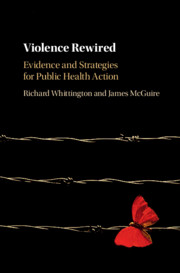Book contents
- Violence Rewired
- Violence Rewired
- Copyright page
- Epigraph
- Contents
- Figures
- Tables
- Boxes
- Foreword
- Acknowledgements
- Introduction and Overview
- Part I Origins
- Part II Solutions
- 6 Advancing a Global Public Health Response to Violence
- 7 Risk Assessment
- 8 Pharmaceutical Interventions
- 9 Psychosocial Interventions
- 10 Changing Structures
- Rewiring Our Expectations
- Appendix Major UN Initiatives to Address Violence, 1986–2018
- References
- Index
8 - Pharmaceutical Interventions
Medication, Violence, and the Public Health
from Part II - Solutions
Published online by Cambridge University Press: 13 March 2020
- Violence Rewired
- Violence Rewired
- Copyright page
- Epigraph
- Contents
- Figures
- Tables
- Boxes
- Foreword
- Acknowledgements
- Introduction and Overview
- Part I Origins
- Part II Solutions
- 6 Advancing a Global Public Health Response to Violence
- 7 Risk Assessment
- 8 Pharmaceutical Interventions
- 9 Psychosocial Interventions
- 10 Changing Structures
- Rewiring Our Expectations
- Appendix Major UN Initiatives to Address Violence, 1986–2018
- References
- Index
Summary
Effective risk assessment, when it occurs, ideally leads to decisions about effective interventions. The multifactorial nature of violence, with its origins in biological, psychological, and social processes operating separately or together, means that interventions at all of these different levels are available for those who present an identifiable violence risk. The challenge is to identify which intervention, or combination of interventions, is most suitable in each case and to find the necessary resources for successful implementation. The next three chapters will consider interventions at each of the levels and examine some of the evidence currently available with regard to their effectiveness. In public health terms, the medical and psychosocial interventions to be considered, respectively, here and in the next chapter, mainly represent tertiary but also some secondary prevention efforts deployed with at-risk populations, or with relatively high-risk individuals who have already acted violently. In contrast, the integrated interventions considered in Chapter 10 often incorporate a primary prevention element in addition, as part of a truly comprehensive approach to the problem.
Information
- Type
- Chapter
- Information
- Violence RewiredEvidence and Strategies for Public Health Action, pp. 186 - 202Publisher: Cambridge University PressPrint publication year: 2020
